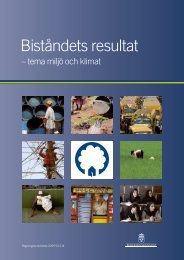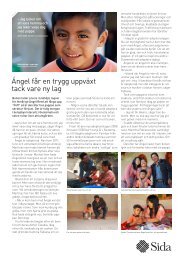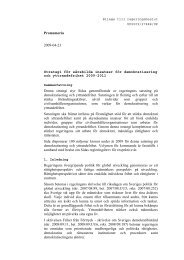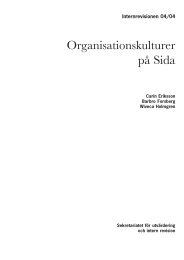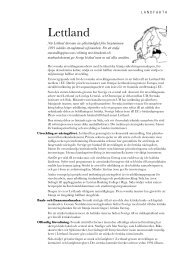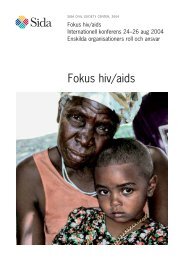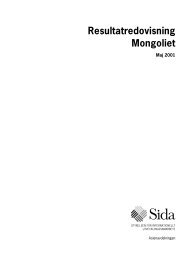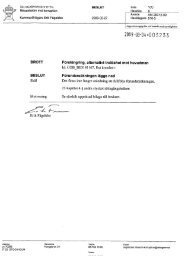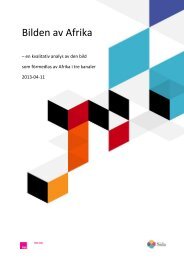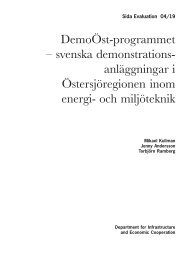Mobilisation of the Poor – a means to Poverty Reduction? - Sida
Mobilisation of the Poor – a means to Poverty Reduction? - Sida
Mobilisation of the Poor – a means to Poverty Reduction? - Sida
Create successful ePaper yourself
Turn your PDF publications into a flip-book with our unique Google optimized e-Paper software.
freedom <strong>of</strong> movement/mobility which women enjoy in Sri Lanka is ano<strong>the</strong>r reason for women’s<br />
long involvement in group savings. Women can put by money for <strong>the</strong>ir own use outside <strong>of</strong> <strong>the</strong>ir<br />
household expenses. 3 Studies on women’s pattern <strong>of</strong> savings have noted that <strong>the</strong>y tend <strong>to</strong> keep <strong>the</strong>se<br />
savings separate from discussions <strong>of</strong> household incomes and expenses, particularly discussions with<br />
spouses. In <strong>the</strong> case <strong>of</strong> seettu savings are used <strong>to</strong> purchase items such as consumer durables,<br />
furniture, jewellery, and expensive clothing, all <strong>of</strong> which may eventually become important dowry<br />
items that move with women during marriage transactions (Albee and Reid 1990, Kottegoda 1994,<br />
2000a and 2000b). These savings are also important resources that <strong>the</strong> family can fall back on at<br />
times <strong>of</strong> illness, crop failures, or o<strong>the</strong>r crisis.<br />
It appears that CAP gradually recognised <strong>the</strong> importance <strong>of</strong> involving women in group-based<br />
poverty alleviation endeavours. Hence although <strong>the</strong> literature on CAP refers <strong>to</strong> a constituency<br />
called ‘<strong>the</strong> poor’, in reality it was poor women who were most able <strong>to</strong> help <strong>the</strong>ir households get out<br />
<strong>of</strong> poverty.<br />
Women as a primary constituency in social mobilisation programmes<br />
The discussions with groups and CAP organisations during our field visits showed that in most<br />
cases <strong>the</strong> CAP programme primarily attracted, and appeared <strong>to</strong> be targeted at, women. Discussions<br />
with group members as well as <strong>of</strong>fice-bearers in newly formed NGOs revealed that <strong>the</strong> mobilisation<br />
at village level targeted women as being <strong>the</strong> people most concerned about <strong>the</strong> welfare <strong>of</strong> household<br />
members. Hence, <strong>the</strong> initial steps <strong>of</strong> CAP group building use <strong>the</strong> communal savings and investment<br />
methodology. For example, each (woman) household member brings an agreed number <strong>of</strong> coconut<br />
shells every week, which are <strong>the</strong>n sold in bulk and <strong>the</strong> pr<strong>of</strong>its shared among group members.<br />
The field data indicates that while <strong>the</strong> participation <strong>of</strong> men in CAP group activities was low, where<br />
women-led groups began <strong>to</strong> show economic pr<strong>of</strong>it, <strong>the</strong>re was a pattern <strong>of</strong> men joining in. Where<br />
male members were involved in small groups <strong>the</strong>y were more likely <strong>to</strong> drop out <strong>of</strong> <strong>the</strong> programme<br />
because <strong>of</strong> employment-related constraints. In o<strong>the</strong>r cases female spouses <strong>of</strong>ten represented male<br />
members in small group activities. On <strong>the</strong> o<strong>the</strong>r hand, instances <strong>of</strong> men participating in small group<br />
activities on behalf <strong>of</strong> female CAP members were rare. There was a perception among CAP<br />
mobilisers that male participants were less serious about <strong>the</strong> group process and were less inclined <strong>to</strong><br />
save. It thus appears that at <strong>the</strong> village level <strong>the</strong>re has been a pattern <strong>of</strong> drawing in women as <strong>the</strong><br />
basic foundation <strong>of</strong> almost all group activities, in particular in relation <strong>to</strong> savings programmes and<br />
<strong>the</strong> building <strong>of</strong> support groups. This was by no <strong>means</strong> restricted <strong>to</strong> <strong>the</strong> CAP programme. As noted<br />
in Chapter 3, even though for Samurdhi purposes <strong>the</strong> male head <strong>of</strong> <strong>the</strong> household is <strong>of</strong>ficially<br />
counted as <strong>the</strong> recipient <strong>of</strong> <strong>the</strong> grants, <strong>the</strong> small groups largely involved women.<br />
Of <strong>the</strong> various community-based organisations in <strong>the</strong> study locations, (see Table 13), CAP small<br />
groups and/or Gami Sanvidanaya had <strong>the</strong> highest participation <strong>of</strong> women, followed by Women’s<br />
Organisations, SANASA, Sarvodaya, and Seettu. This confirms that women are <strong>the</strong> primary<br />
constituency <strong>of</strong> CAP small groups, and that out <strong>of</strong> all community-based organisations <strong>the</strong> pattern<br />
<strong>of</strong> female participation is most pronounced in CAP entities at <strong>the</strong> grassroots level. As discussed<br />
elsewhere in this report, this is also an aspect <strong>of</strong> <strong>the</strong> greater resilience and sustainability <strong>of</strong> <strong>the</strong> CAP<br />
group process.<br />
3 It is pertinent <strong>to</strong> note that <strong>the</strong> CAP programme in particular has spread most widely in <strong>the</strong> south and has been largely<br />
inactive in <strong>the</strong> north and east, where <strong>the</strong>re has been a state <strong>of</strong> war for almost two decades and hence where women’s<br />
mobility is likely <strong>to</strong> be most curtailed.<br />
34<br />
MOBILISATION OF THE POOR <strong>–</strong> A MEANS TO POVERTY REDUCTION <strong>–</strong> <strong>Sida</strong> EVALUATION 02/08




